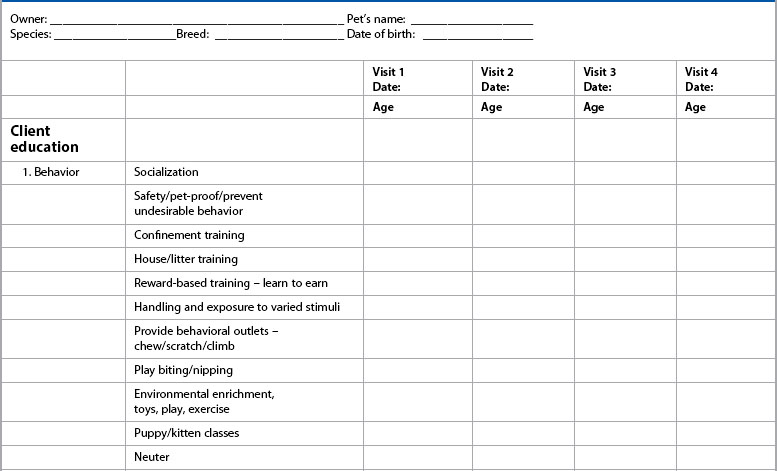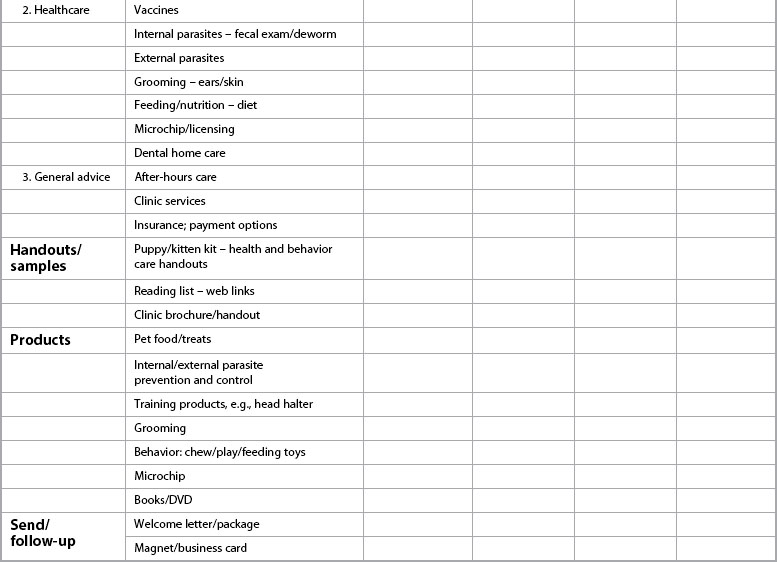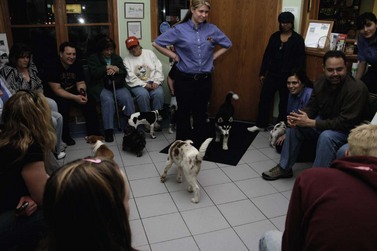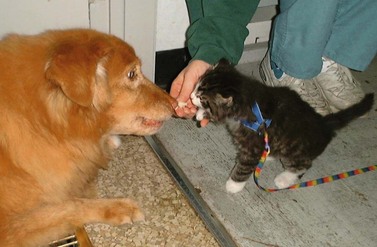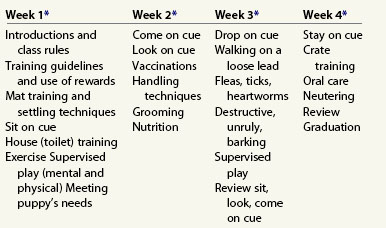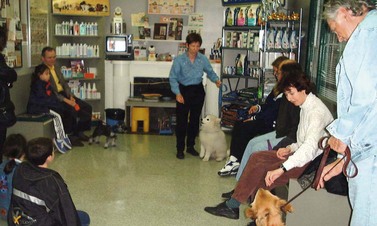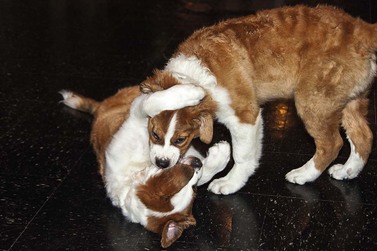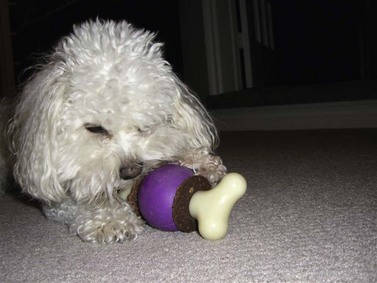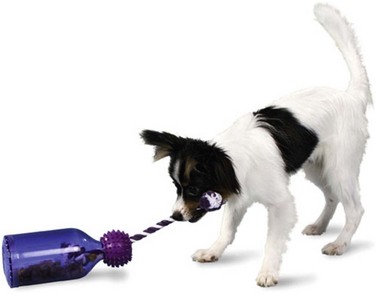Chapter 4 Prevention
the best medicine
Working with new puppies and kittens – the team approach
Providing timely behavioral advice to new puppy and kitten owners can help prevent undesirable behaviors, as well as help correct existing problems before they become resistant to change.1 The first veterinary visit is the time to introduce the family to important concepts about behavior, learning, and training. Don’t assume that the family knows how to raise a young pet correctly and effectively. Preventive advice should be offered to all new pet owners, so that they know what is needed and what to expect when raising their pet. Unrealistic owner expectations, insufficient or incorrect counseling and instructive material, lack of training, allowing the pet to roam outdoors, failure to neuter, destructive behavior, and housesoiling have been shown to increase the risk of owner relinquishment.2,3 These are issues that need to be discussed with all owners. A list of topics that should be discussed can be found in Box 4.1.
Box 4.1
Topics that should be discussed with each new pet owner, and that can be a major focus of staff training and involvement in preventive behavior counseling
• Socialization with people and animals of all types
• List of appropriate reading material, websites, and DVDs
• Providing a safe environment by pet-proofing the home and yard
• Supervision, confinement, crate training
• Housetraining, litterbox training
• Enrichment, play, and exercise
• Chewing, scratching, and destructive behaviors
• Reward-based training and shaping desirable behaviors
• Giving pets control to make choices that are acceptable to owners
• Basic grooming needs, nail trimming
• Outdoor safety and pet ID (e.g., microchip)
• Health advice – vaccinations, nutrition, parasites, dental care, neutering, care pathways
• Pet health insurance and other risk management strategies
• Training tools (e.g., head collars, leads, harnesses, toys)
To make matters more expedient during those initial few veterinary visits, it is useful to have a new pet checklist, so that points can be addressed in an orderly manner and important topics don’t get missed. Advice to owners can be provided over the course of the puppy and kitten visits (Form 4.1). As long as the information is properly prioritized, and given at an appropriate time in the pet’s development, not all information needs to be provided at once. Preadoption consultations and puppy or kitten classes provide additional opportunities to educate and counsel the new pet owner.
Form 4.1
New puppy or kitten checklist (client form #12, printable version available online)
Species: ____________________Breed: Date of birth:
Proper use of hospital staff will give the veterinarian more time to concentrate on important aspects of behavior and training within the time frame of a typical initial office visit. Veterinary staff can be trained to cover all of the topics listed in Box 4.1. In addition, the use of a variety of personnel, as well as a variety of resources (e.g., handouts, videos, websites, reading lists) may be a more practical way to educate the family. In addition to the handouts available throughout this text (also provided online), two resources for client handouts are those available from the American Animal Hospital Association (AAHA: www.aahanet.org: co-authored by Dr. Hunthausen and Dr. Landsberg) and a compilation of over 100 canine and feline client behavior handouts (www.lifelearn.com: co-authored by Dr. Debra Horwitz and Dr. Landsberg). Another option is to provide useful web links for your clients on your website.
Socialization and habituation
Socialization has been discussed in Chapter 2 but is mentioned again here as it is one of the most important concepts for the veterinarian to introduce to the family with a new pet.4 Puppies and kittens need to be handled frequently and have positive contact with a variety of people and other animals, objects, and environments early in their lives in order to become normal, friendly, confident adults. Socialization is the process by which pets develop a relationship with animals of their own species and other species. Socialization is a special learning process whereby a pet learns to accept the close proximity of others in its world. The most critical period for socialization (sensitive period) in puppies starts at 2.5–3 weeks and declines at 12 weeks of age, while the most receptive period for kittens is from 2 to 7 weeks of age.5–7 During these periods, puppies and kittens show little fear of strangers and novel objects and will generally explore and play with everyone and everything they meet. At this time attachments will be made with their own and other species most rapidly and without the need for counterconditioning.8 Pets that develop social relationships during these periods are often capable of maintaining these relationships for life. The sensitive period is also a time for pets to form attachments to places (or localization) in which potential environmental fears can also be reduced by exposure.9,10 Pets that are regularly exposed to a variety of people, pets, and complexity in the form of novel objects, experiences, toys, textures, sounds, and regular handling (both sexes, various ages and appearances) are likely to be friendly and form stable attachments to both the “living and nonliving parts of their environments.”9 Social deprivation may prevent the establishment of normal socialization, and can affect learning, fear responses, sexual behavior, and social preferences.11–16 Although these are sensitive stages for primary socialization, continued socialization is also necessary for social relationships to be maintained to prevent regression. For appropriate social development, the breeder should begin handling and provide careful environmental enrichment shortly after birth.17,18 Puppies and kittens that do not receive sufficient auditory, tactile, and visual stimuli may be slower learners, less social, and more fearful than properly stimulated and socialized littermates. Adequately stimulated puppies and kittens have superior coordination, higher sociability toward people, and better problem-solving scores, and are less fearful in novel situations.19 In fact, early handling and mild stress may produce a change in the pituitary-adrenocortical system that helps the pet to cope better with stressful situations later in life.20 Breeders who isolate puppies or kittens and deprive them of sufficient early handling may produce pets that are overly fearful and lack desirable social behavior.
Another critical factor in the early development of dogs and cats is the role of the mother. The behavior of the bitch and queen also can affect behavior. Bitches with good maternal behavior produce offspring that are more confident and less easily stressed while those that are anxious or ambivalent are likely to produce clingier, overdependent infants.10 In studies of cats and rodents, mothers that were undernourished produced offspring with poorer learning ability and altered social relationships with other cats, and were more fearful and aggressive.21 Maternal deprivation has also been found to contribute to aggressiveness, heightened fearfulness, anxiety, social abnormalities, and the development of stereotypic behaviors.22 Dogs and cats that have been deprived of maternal and peer interactions form poor social bonds later in life since this is a time in which future social partners are determined and the species to which it belongs is defined.10 For example, if a puppy or kitten is removed from the litter at birth and hand-reared, it may be unable to mate or care for its own litter later in life, and may have increased aggressiveness, anxiety, and social abnormalities with both humans and its own species.22
In addition, the socialization period not only determines the pet’s future social partners but also effectively helps it adapt to the species to which it belongs.10 The socialization period is particularly important for intraspecies identification and appropriate development of intraspecific communication. The animal also learns to develop what is and is not acceptable behavior with its mother and other members of its species. During this time dominant and subordinate signaling is refined which helps reduce the number and seriousness of play fights and helps the dog learn to resolve conflicts without aggression.5,9 With insufficient early social interaction with conspecifics such as with solely hand-reared pets, dogs and cats may become overly rambunctious and less inhibited in their social interactions with family members.
Puppies or kittens removed from the litter at 4 weeks of age or younger may not be able to relate appropriately to members of their own species at a later age. Therefore, it is generally recommended that puppies remain with their mother and littermates until approximately 7 weeks of age, so they can develop communication skills and social skills and have an opportunity to play and interact with other dogs. It is equally important for kittens to develop and maintain proper social relationships with other cats. However, since the most sensitive period for socialization in cats begins to wane as early as 7 weeks of age, social contact with people and other species must begin before this time. In order to accomplish good intraspecific socialization skills, continued socialization with other members of its species should continue throughout the socialization period, even after the pet moves into the new home. Having more than one dog or cat in the home, visiting with the pets of friends and relatives (if healthy, social and vaccines are up to date), avoiding areas where viruses and parasites might be picked up, along with puppy or kitten classes are often the best ways to develop and maintain good social skills with conspecifics (Figure 4.1).
Every attempt should be made to introduce the puppy to people, animals, and environments that it might be likely to encounter in adulthood. When reviewing the examples, be certain to have the family concentrate on stimuli that differ from those in the daily household (Box 4.2). An excellent way for owners to socialize their puppies to new people is to use the concept of socialization biscuits (Appendix C, form C.2, client handout #3, printable version available online). The owner should take the puppy into novel situations armed with a container of small treats. The puppy should be encouraged to approach people it meets along the way (e.g., children, joggers, cyclists, postal workers). When the puppy responds appropriately without any apprehension, the owner gives the stranger a biscuit treat to give to the puppy. A treat, toys, and some play are usually all that is required to socialize most puppies (and most kittens) (Figure 4.2). Note that if the puppy greets properly (i.e., sitting, walking by, not jumping up), the reward can be given without the need for the verbal cue. The same can be done with the staff in the veterinary clinic and visitors coming to the home. This is a time when not only social relationships need to be established, but also when the puppy is most open to becoming comfortable with new stimuli and to making attachments to new places. During this period, strong fear-eliciting situations and stimuli must be avoided. However, the owner should also be told that even properly socialized puppies may exhibit protective and warning behaviors such as barking.
Box 4.2
Stimuli for socialization and habituation of puppies and kittens. Any exposure that does not end in a positive outcome should be avoided, and reintroduced in a more graded manner (desensitization) and with a positive outcome such as treats or play (counterconditioning)
Animate stimuli – expose to sights, sounds, smell, movement, positive handling of the following
Variety of people (children/babies, teenagers, adults, males/females, elderly)
People with different hair lengths, color, styles
People with different complexions, color
People wearing uniforms, backpacks, hats, headgear, glasses
Physically or mentally challenged (wheelchairs, walkers, canes, altered mobility)
People and associated activity/noise (e.g., playing sports, skateboards, roller blades, bicycles)
Veterinarians/veterinary staff
Inanimate stimuli – expose to sights, sounds, smell, and contact with the following
Unfamiliar locations – veterinary clinic, visit to family members or neighbors
Cars, trucks, bikes (pedal and motor), trains
Roadway, sidewalk, pavement, footpath
Stimuli that are novel/unique to the new environment (e.g., planes, trains, hot-air balloons)
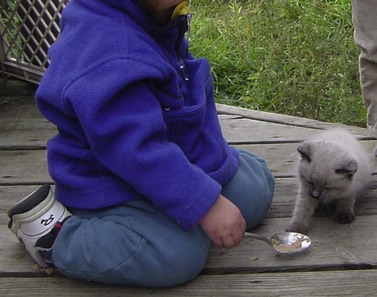
Figure 4.2 Child greeting and counterconditioning a new kitten using canned food from a spoon.
(Courtesy of Theresa DePorter.)
Overall, the factors for optimum socialization and prevention of fear and avoidance include: (1) early gentle handling by the breeder; (2) maternal reared in a domestic environment with exposure to humans and varied stimuli; (3) adoption into the new home during the socialization period; (4) a variety of positive social experiences and new environments throughout the socialization period; (5) continued social interactions and stimulus exposure through the juvenile period, and (6) avoidance of negative social experiences. (Box 4.3). DVDs and CDs can be obtained for sound exposure and desensitization. Puppies with a nondomestic (kennel-reared with minimal human interaction) maternal environment and insufficient socialization and localization are at increased risk for developing avoidance behavior near unfamiliar people, dogs, noises, and places, and fear-related aggression.
Box 4.3
Steps for optimum social development of puppies and kittens (Available as Client Handout 29)
1. Choose breeding animals that exhibit desirable social behavior
2. Select pets that have been raised in a domestic (home) environment by their mother
3. Choose pets that have had handling and early stimulation (rather than isolation and avoidance)
4. Provide opportunities for socialization with humans and other species prior to the end of the socialization period
5. Habituate to as many stimuli and environments as practical during the early months of life
6. Consider all people, animals, stimuli, and locations to which the pet may be exposed at a later age but are not presently in the environment and seek out exposure. Be particularly diligent about exposure to children, the elderly, or people who are physically or behaviorally different from family members
7. Avoid excessively fearful situations and exposures – monitor the pet for any emerging signs of fear and keep all meetings and greetings positive. Use toys or treats for a positive association
8. Continue exposure to conspecifics into adulthood to maintain healthy social relationships
9. Consider puppy and kitten classes for early training and socialization in a controlled environment
Cats that have had no social contact with people by 7–9 weeks of age may not be able to develop a healthy social relationship with humans. Therefore, ideally a kitten should be either removed from the litter and taken into its new home by 7 weeks of age, or the potential owner must ensure that the kitten has had adequate interactions and handling by people and other potentially fear-evoking stimuli before it is obtained. Once obtained, the family should focus on socialization and habituation to people and pets both in the home as well as those that differ from the present household and family (Figure 4.3). Wherever possible, provide treats when meeting or greeting new people or pets, so that a positive association can be made. A client handout on kitten socialization can be a useful tool (see Appendix C, form C.3, client handout #18, printable version available online). Owners should attempt to maintain their kitten’s social skills with other cats by having more than one cat in the home, visiting friends with healthy, vaccinated, sociable cats, or by attending kitten kindergarten for a practical opportunity for varied exposure (discussed below).
Puppy classes and kitty kindergarten
One way to achieve socialization to a variety of people and other pets is to take puppies to puppy classes and kittens to kitty kindergarten (Figures 4.1, 4.5, 4.6 and Boxes 4.4 and 4.5).23,24 For maximum benefit for the veterinary hospital these classes should be run by suitably trained staff members in the hospital facility. The goals of these classes are to provide continued socialization to a variety of people and pets, and to educate owners in the training and management of pets and prevention of behavior problems.
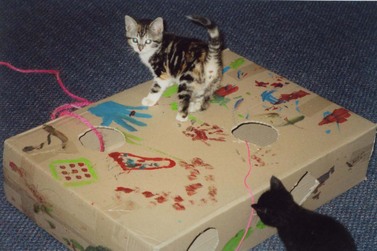
Figure 4.5 Two kittens playing with an exploration toy at kitty kindergarten.
(Courtesy of Kersti Seksel.)
Box 4.4
Guidelines for puppy classes (client form #14, printable version available online)
Puppy Preschool outline
Ideally the first class is run without puppies being present so that owners can focus on the topics covered rather than be distracted by the puppies. The following four classes can then cover other topics and give practical demonstrations. Each week the class generally involves some training, guidance on canine health issues, and discussion of normal puppy behaviors, and how to prevent these behaviors becoming problems in the home. For more details, see Figure 4.6 or visit www.hillspuppyschool.com.au.
Number of puppies
Puppy Preschool classes should ideally have no more than six puppies in each class. Having more puppies in a class can make it more difficult to manage and can lead to a significant increase in vocalization which is distracting and disruptive and can interfere with learning. Adaptil collars or a diffuser in puppy classes can reduce fear and reactivity and may enhance the socialization process.1,2
1Graham D, Bailey G, Mills DS. The effect of temporary exposure to synthetic dog appeasing pheromone (DAP) on levels of arousal in puppy classes. J Vet Behav 2007;2:90.
2Denenberg S, Landsberg GM. Effect of dog-appeasing pheromones on anxiety and fear in puppies during training its effects on long term socialization. J Am Vet Med Assoc 2008;233:1874–82.
*Note that some puppy class instructors choose to include a) structured and guided play sessions at each class and b) positive (rewarded) exposure to different stimuli at each class such as i) people wearing work uniforms or costumes, ii) movement and noises ranging from bikes and skateboards to wheelchairs and iii) different surfaces textures to walk over (rubber mats, grating) or objects to walk through (e.g. agility structures)
Box 4.5
Guidelines for kitten classes (client form #11, printable version available online)
Kitten class outline
| Class 1 (no kittens) | Class 2 (with kitten) | Class 3 (with kitten) |
|---|---|---|
| Introduction and class rules Training with rewards Settling techniques Litter box care Meeting kittens’ needs Mental/physical enrich, explore, scratch, climb, perch Confinement/safety Internal/external parasites Nutrition Come on cue | Reward train Look/sit on cue Stay on cue Gentle handling techniques Grooming, nail trim, oral care Vaccinations Socialize Toy exploration | Lie down on cue Walk on harness and lead Foraging toys and predatory/chase toys Teaching tricks Neutering Discuss problems Review Graduation |
• training for good manners (at home and when out)
• positive handling (including grooming and veterinary procedures)
• normal behavior and providing for the pet’s behavior needs
• how animals learn and shaping desirable behavior
• setting up the household for success
• play biting and unruly behavior
See the puppy class training outline (Box 4.4) and the kitten kindergarten outline (Box 4.5) for specifics.
These classes help emphasize your clinic’s interest and expertise in providing behavioral advice, and expand the services you offer. The class should have a minimum of three to four pets to provide opportunities for socialization, with a maximum of six. Ideally there are at least two instructors so that there is one instructor for each three puppies or kittens. During some sessions, puppies and kittens should have structured play. In Dr Seksel’s Puppy Preschool she prefers to limit play to two puppies off leash at a time (Figure 4.4). Structured and supervised play with conspecifics (especially in dogs that have no other dogs in their home environment) provides an opportunity to develop socially acceptable behaviors and refine communication skills between members of the species. Social interaction with people and other pets as well as some demonstration and guidance on reward-based training techniques should also be covered. Any emerging problems should be identified and appropriate management and solutions discussed. Puppies in these classes are better trained and have earlier and effective behavior problem intervention compared with puppies that do not attend puppy classes.24 In addition, puppies attending well-designed puppy classes had higher rates of retention as adults and were less likely to show undesirable behavior to unfamiliar dogs.25,26 In one study, dogs wearing dog-appeasing pheromone (Adaptil) collars were less fearful and anxious, had more positive interactions, and in follow-up surveys for 1 year were consistently more social and faster to adapt to new situations than puppies wearing placebo collars.27
Veterinary hospitals that do not have sufficient space to run these classes might consider having a monthly 1–2-hour puppy or kitten socialization “party” in the reception area (Figure 4.6). During this get together (open house), families can bring their new pets, meet the staff, take a tour of the hospital, and get additional information on behavior, nutrition, grooming, and dental care, and the pets may have some social time with other people and pets. A few refreshments for owners and pets and some free samples might also be a good way to encourage attendance. If your clinic recommends a local trainer for puppy or kitten classes, you could have the trainer attend the open house to give a brief demonstration, supervise some socialization activities, and sign up pets for the classes.
One major concern of some veterinarians and pet owners is the risk of disease to puppies and kittens that have not yet finished their vaccination series. However, in order for socialization classes to be optimally effective, they should begin well within the primary socialization period (i.e., before 12 weeks of age). Therefore the risk of disease must be weighed against the potential benefits of early socialization and training. If puppies and kittens have been examined and found to be in good health and free of parasites, have been vaccinated at least 14 days earlier, and continue to receive their vaccinations in a timely manner, then bringing them into an indoor training environment with other pets their own age should be a minimum risk compared with the benefits that might be achieved. In fact, this type of well-screened and supervised environment might be less risky than a walk along the street, or a trip to other areas frequented by pets. Risk can be further reduced by ensuring that the pet has been in the new home for a reasonable length of time (e.g., beyond the incubation period for common infectious diseases) before beginning classes. Training could begin later in areas where infectious diseases with high morbidity or mortality are endemic (enzootic) or epidemic (epizootic). A recent study found no association of parvovirus with attendance at puppy classes.28
Environmental enrichment
Punishment can cause fear and anxiety, adversely affect the bond, and at best only teaches the pet who, what, and when to avoid rather than training the pet what is desirable. Focusing on the prevention of problems and setting up an environment in which the pet can succeed improves the welfare of the pet and the pet–family bond, and reduces those behavioral problems that can damage or break the bond.29–31
It is important for the family to understand that they must provide for all of the pet’s needs. Besides nutrition, health, and shelter, dogs and cats have very important social, physical, and mental stimulation requirements. If these are not met in dogs, a variety of undesirable behaviors may develop, including unruliness, hyperactivity, undesirable play behavior, unwanted exploratory behavior, destructiveness, conflict-induced behaviors such as self-trauma, nocturnal activity, and attention-seeking behaviors. In cats, the consequences might include elimination, scratching, aggression, anxiety, vocalization, and excessive activity.32 Since most pets are considered as family members, it is also important to realize that not comprehending and meeting a pet’s true needs is also likely to produce a less than satisfactory family–pet relationship.33 Accordingly, some of the goals of environmental enrichment include increasing behavioral diversity, reducing the frequency of unacceptable behaviors, increasing the range or number of typical behavior patterns, increasing positive utilization of the environment, and increasing the ability to cope with challenges in a more productive and healthy manner.34 See Boxes 4.6 and 4.7 for guidelines for environmental enrichment for dogs and cats.
Box 4.6
Suggestions for environmental enrichment for dogs (see Client Handout 30)
Sensory enrichment
These might include a radio, television, or DVD, toys that squeak, and foraging devices.
Manipulative toys and objects
A wide variety of toys are available from commercial companies. Many dog chew toys are made of durable rubber and may have grooves or holes where chew products, food, or treats can be stuffed (Figure 4.8). Safety and characteristics of toys that are interesting to the individual pet will determine which toys are appropriate. Toys should not be so small or fragile that they can be chewed and swallowed, nor so hard that a tooth could be broken. There are many toys available that are designed to be stuffed, coated, or filled with food, treats, or chews and require some form of manipulation to dispense the food. Freezing the food in the toys will increase the time the pet spends with it. Other toys are designed to be moved around so that dry food or treats will fall from openings in the toys (Figure 4.9). Rabbit, quail, and other “wildlife scents” (available from sporting goods stores) can be smeared on toys to increase their appeal; however, care should be taken with some dogs that it does not increase predatory instincts. Sturdy, fleece toys that can be grabbed and shaken are very appealing to some dogs and can satisfy a need for predatory play. Squeak toys produce a high-pitched, prey-like noise that appeals to many dogs. Periodically rotating toys in and out of the pet’s environment will recharge the novelty of the toys.
Box 4.7
Suggestions for environmental enrichment for cats (see Client Handout 31)
Feeding
Toys are available that can be filled with canned food and cheese for the pet to empty. Freezing the food in the toys will increase the time the pet sends with it. Other toys are designed to be moved around so that dry food or treats will fall from openings in the toys, such as the pipolino, FunKitty, or Kitty Kong toys (Figure 4.10).
Stay updated, free articles. Join our Telegram channel

Full access? Get Clinical Tree


